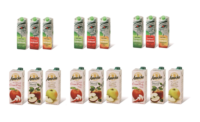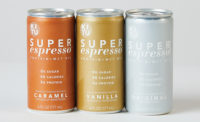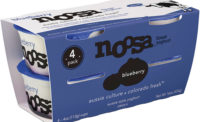Texture combinations make food more complex – and more sophisticated




Food and beverage experts are certain: the industry is waking up to the issue of texture. Texture has a significant influence on the perception of taste and aroma. Even more importantly, unusual textures make eating and drinking exciting. And a product that consumers perceive as something special has a good chance of finding its way into the shopping basket again.
Julia Trebels, Product Manager at SIG Combibloc: “Texture is determined by a number of aspects. These include everything we can detect with our senses – with the tongue and palate, but also with the eyes, hands and ears. Combining different textures in a product enhances its structural complexity. And that arouses the interest of consumers who believe eating and drinking should not only pursue the primary objective of satisfying hunger and thirst – it should also be fun. More and more people are adventurers when it comes to food. In addition to things they’re already familiar with, they like to try new foods in order to discover exactly what best meets their own tastes and their current needs”.
Texture provides orientation
Is a food item fresh or elaborately processed, soft or crisp, crunchy or velvety? All this information comes from the texture. The texture of a food should therefore play a key role in the product design and development, to ensure the product is right for the desired target market and the desired target group in each case. What sort of texture will be perceived as enjoyable depends partly on cultural background, but also on when a beverage is to be consumed. Julia Trebels: “For instance, people tend to want thirst-quenching soft drinks to be quite thin, tangy and light. On the other hand, if the main priority is pure enjoyment, a beverage can be much creamier and rich. Added extras such as pieces of nuts or fruit, bits of chocolate, grains or seeds can enhance the enjoyment factor of a beverage, and its complexity. Bits such as these make it possible to intensify and prolong the pleasurable experience of eating and drinking, in that the flavors don’t all hit the consumer simultaneously, but to a certain degree are delayed due to the differing textures”.
Perceptible added value
Modern processing, filling and packaging technologies enable food manufacturers to offer a wide range of products with particular textures that are, for instance, ‘extra crunchy’, ‘extra creamy’, ‘super juicy’, ‘melt in the mouth’ or ‘even fruitier’, or the product’s particulate content may give it a particular texture. Julia Trebels: “The drinksplus technology from SIG Combibloc gives beverage manufacturers the option of adding products with unusual textures to their portfolios, and aseptically packaging them in carton packs using standard filling machines for liquid dairy products and non-carbonated soft drinks. The technology means small pieces of fruit or vegetables can be added to a beverage just as easily as seeds, grains, nuts or coconut flakes. The proportion of particulates, which gives the beverage a perceptible added value in the truest sense of the word, can be up to ten per cent. The individual bits can be up to six millimeters in length and width”.
A wide range of product concepts have already been implemented with the drinksplus technology, and positioned successfully in various parts of the world. As one of the most recent examples, major Chinese dairy group Mengniu Dairy has launched a premium milk containing oats and wheat grains – thus introducing China to the product category of the milk meal you can drink. Julia Trebels: “In this product category, texture plays a special role, because it’s a kind of information carrier that tells the consumer he’s drinking something high quality, nutritious and satisfying”.
The drinksplus technology is also suitable for non-carbonated soft drinks, which take on a special character with the addition of extra bits. Korean company Haitai Beverages, for instance, has recently brought out two ‘Sunkist’ brand premium smoothies, which are given a special texture and authenticity by pieces of real fruit, providing for an exceptional drinking experience. The products are available in Apple/Mango with apple bits, and Strawberry with peach bits.
Slender solution for additional food products
In the area of food products too, texture plays an important role. “But food manufacturers don’t always need a high-end solution for filling food products when they decide to expand their portfolio by adding products with a different texture. For instance, a whole host of food products can be filled using the leaner Food Option filling machines from SIG Combibloc, which are based on the standard aseptic filling technology for beverages but additionally can fill a wide range of other pasty and highly viscous food products, as well as products containing particulates”, says Julia Trebels from SIG Combibloc. With a Food Option filling machine, products with up to 10 per cent chunky ingredients can be aseptically filled. Individual particulates can be up to 6 mm in size. Fibers can be 1 x 15 mm, with viscosity potentially up to 3,500 mPas. With the Food Option filling machines, the know-how from the field of aseptic food filling technology has been transferred to the standard filling machines for beverages, without bringing additional complexity into the overall system and without high investment costs.
German dairy company frischli, one of the leading providers of dairy products for bulk consumers, has – among others – a Food Option filling machine from SIG Combibloc in operation, giving the company a solid foundation on which to aseptically fill a wealth of different products and respond efficiently to market requirements, with a high degree of flexibility. With the Food Option filling machine from SIG Combibloc, frischli is able to fill not only milk, cream and milk drinks, but also more viscous dessert sauces, puddings and custard. A total of around 100 different frischli products are set to be available in carton packs from SIG Combibloc. Dr Timo Winkelmann, General Manager at frischli: “Particularly for the desserts, the texture of the products plays a crucial role. If a pudding isn’t creamy enough, it won’t survive in the market. The taste of a product is very much influenced by the mouth feel that the consumer experiences when eating it. Finding the right recipe also means deciding on a texture that is right for the product, the target group and the intended use”.
Julia Trebels of SIG Combibloc: “Food manufacturers are well-advised to give careful attention to texture also when designing the packaging for this sort of product. The use of images, illustrations or texture claims is suitable for giving consumers information about the product texture right there at the sales shelf, which can help with their purchase decisions. And this information is also necessary so that the consumer understands the product concept and knows what to expect. Texture characteristics help the consumer put in his shopping trolley precisely those products that suit his taste preferences”.
Looking for a reprint of this article?
From high-res PDFs to custom plaques, order your copy today!








